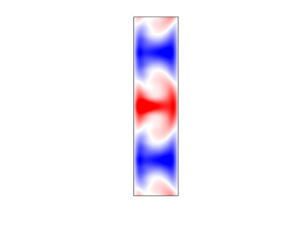Article contents
Closing the loop: nonlinear Taylor vortex flow through the lens of resolvent analysis
Published online by Cambridge University Press: 04 August 2021
Abstract

We present an optimization-based method to efficiently calculate accurate nonlinear models of Taylor vortex flow. Through the resolvent formulation of McKeon & Sharma (J. Fluid Mech., vol. 658, 2010, pp. 336–382), we model these Taylor vortex solutions by treating the nonlinearity not as an inherent part of the governing equations but rather as a triadic constraint which must be satisfied by the model solution. We exploit the low-rank linear dynamics to calculate an efficient basis, the coefficients of which are calculated through an optimization problem to minimize the triadic consistency of the solution with itself as well as the input mean flow. Our approach constitutes, what is to our knowledge, the first fully nonlinear and self-sustaining, resolvent-based model in the literature. Our results compare favourably with the direct numerical simulation (DNS) of Taylor–Couette flow at up to five times the critical Reynolds number. Additionally, we find that as the Reynolds number increases, the flow undergoes a fundamental transition from a classical weakly nonlinear regime, where the forcing cascade is strictly down scale, to a fully nonlinear regime characterized by the emergence of an inverse (up scale) forcing cascade. Triadic contributions from the inverse and traditional cascade destructively interfere implying that the accurate modelling of a certain Fourier mode requires knowledge of its immediate harmonic and sub-harmonic. We show analytically that this is a direct consequence of the structure of the quadratic nonlinearity of the Navier–Stokes equations formulated in Fourier space. Finally, using our model as an initial condition to a higher Reynolds number DNS significantly reduces the time to convergence.
Information
- Type
- JFM Papers
- Information
- Copyright
- © The Author(s), 2021. Published by Cambridge University Press
References
REFERENCES
- 4
- Cited by


